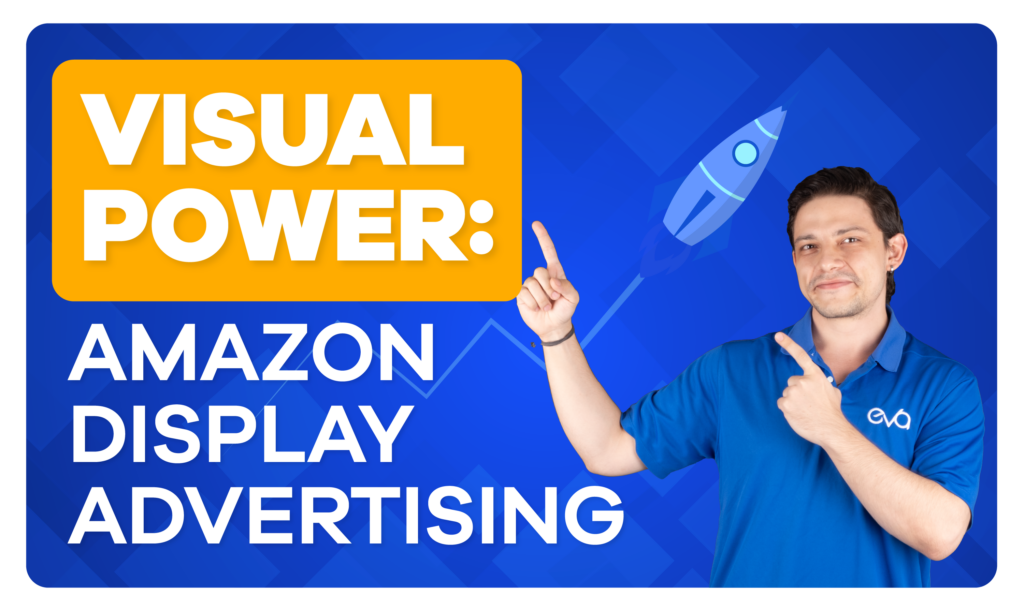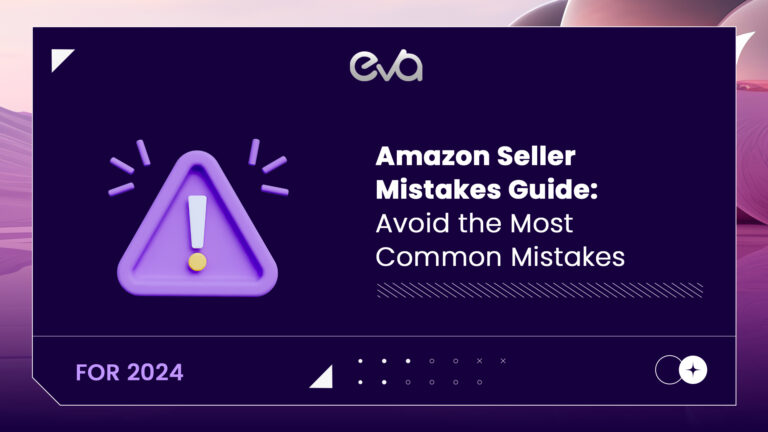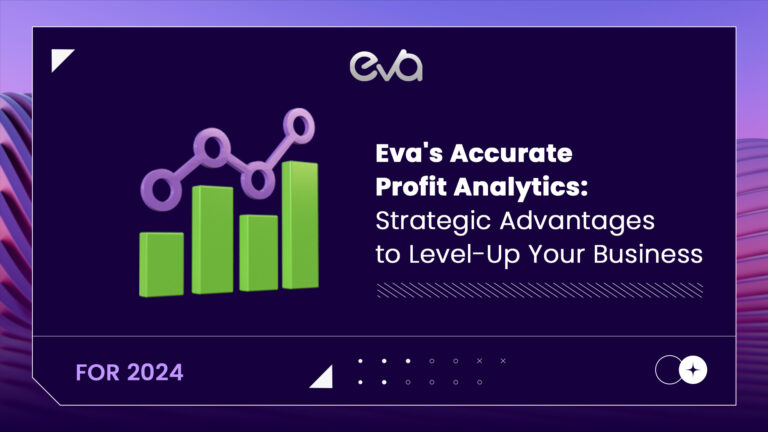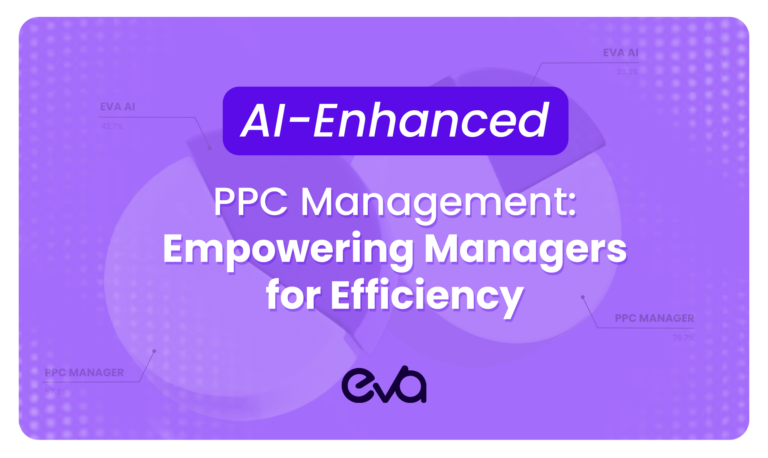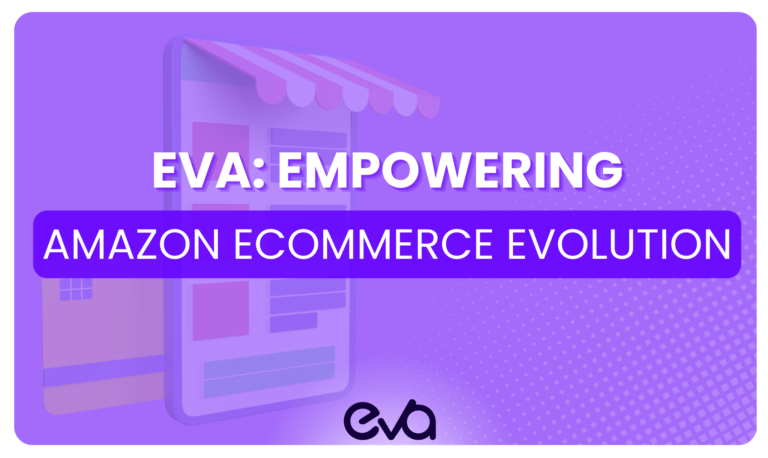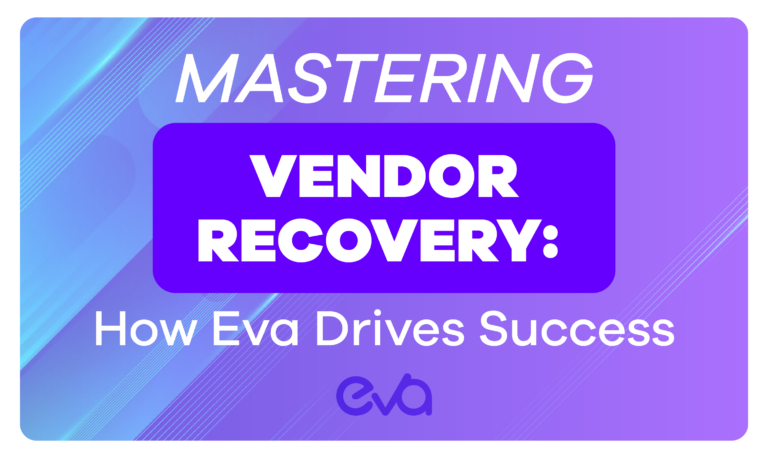Table of Contents
- Introduction
- Contextual and Audience Targeting in Advertising
- How do Sponsored Display ads work?
- What Are The Benefits Of Sponsored Display Ads?
- Amazon Sponsored Display Ads Placement
- Who can use Sponsored Display Ads
- Amazon Sponsored Display Ads’ Role in Your Sales Funnel
- Eva Impact
- How Much Does Amazon Charge for Sponsored Display Ads
- Conclusion
Introduction
Amazon’s marketplace is a bustling hub where millions of products vie for the attention of consumers. In this competitive landscape, Amazon Sponsored Display Ads have emerged as a powerful tool for sellers and brands to boost their visibility and drive sales.
But what exactly are these ads, and how can they benefit your business?
- Definition: Amazon Sponsored Display Ads are a type of advertising that allows sellers to promote their products directly on Amazon’s platform. These ads are displayed to potential customers based on specific targeting criteria, such as their shopping behavior or interests.
- How They Work: These ads use Amazon’s vast data on user behavior to place your products in front of the right audience, whether they are browsing on Amazon or exploring other websites and apps.
There are two types of targeting options available with Sponsored Display ads.
In this blog, we will delve into the details of each type, how to benefit from specific ads & much more so lets dive in!
Contextual and Audience Targeting in Advertising
In the realm of digital advertising, two prevalent strategies stand out: contextual and audience targeting. Both approaches offer unique advantages and can be used effectively in various advertising campaigns, including those on platforms like Amazon.
Contextual Targeting
Contextual advertising, which involves placing ads in relevant content environments, can be broadly categorized into two types based on the focus of the ad: individual products and category.

Each type serves a different purpose and is suited for different advertising strategies.
| Type of Contextual Ad | Definition | How it Works | Advantages | Ideal Use Cases |
|---|---|---|---|---|
| Individual Products | Ads tailored to promote a single product, placed in directly relevant content environments. | An ad for a specific model of running shoes appears in a blog about marathon training. | High relevance, targeted audience, product-specific messaging. | Promoting new products, highlighting unique features, targeting niche markets. |
| Product Categories | Ads promoting a broader category of products, placed in content related to general interests of that category. | An ad for a range of outdoor camping gear appears on a website about outdoor activities. | Broader appeal, brand awareness, flexibility in product promotion. | Establishing brand presence in a market segment, promoting seasonal or thematic product lines. |
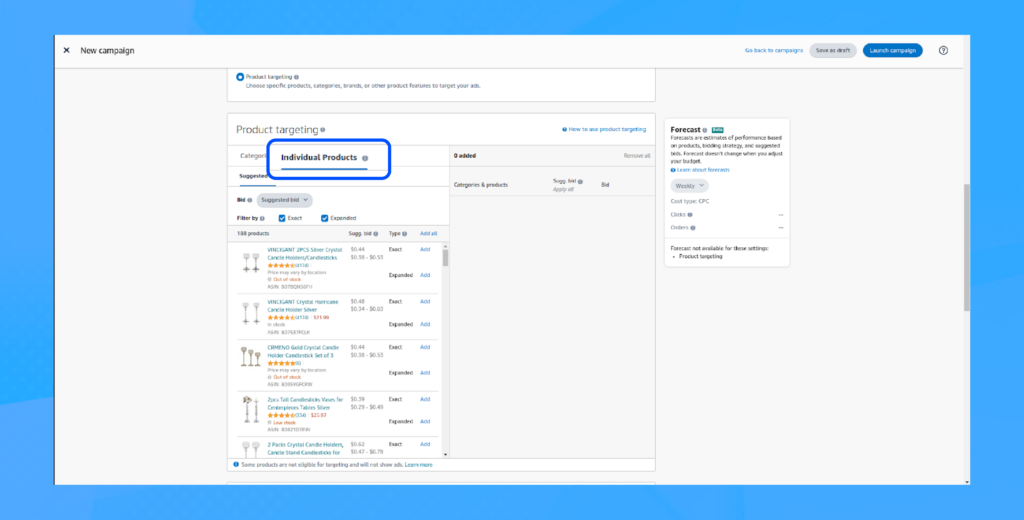
Audience Targeting
Audience targeting in advertising refers to the practice of segmenting consumers into groups based on various characteristics and then tailoring advertising messages to these specific groups.
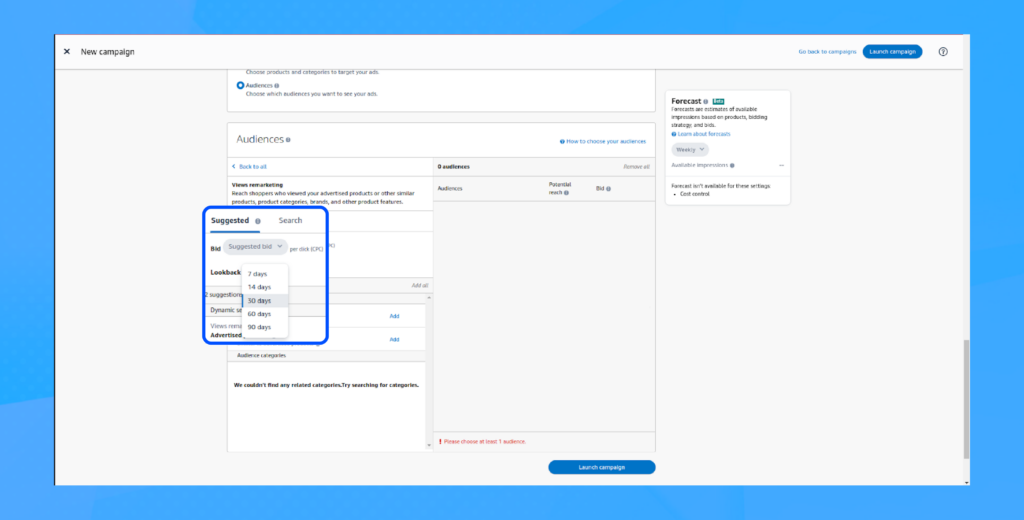
This segmentation can be based on demographics, interests, behaviors, and other psychographic factors.
| Type of Audience Targeting | Description | Key Characteristics | Ideal Use Cases |
|---|---|---|---|
| Amazon Audiences | Targets specific audience segments based on Amazon’s rich customer data, including shopping and browsing behaviors. | – Leverages Amazon’s extensive data. – Can target based on interests, past searches, and purchase history. – Highly relevant to Amazon shoppers. | – Launching new products on Amazon. – Targeting customers with specific interests related to your product. – Reaching out to frequent Amazon shoppers. |
| Views Remarketing | Focuses on users who have viewed specific products or pages but have not made a purchase. | – Targets potential customers who showed interest. – Reminds and encourages them to revisit and complete the purchase. – Can be highly personalized based on viewed products. | – Encouraging undecided shoppers to make a purchase. – Promoting related products to those viewed. – Increasing conversion rates from browsing to buying. |
| Purchases Remarketing | Targets customers who have previously made a purchase, for repeat buying or related products. | – Focuses on past buyers, a potentially loyal customer base. – Can promote complementary products, accessories, or repeat purchases. – Utilizes purchase history for personalized marketing. | – Promoting repeat purchases or subscriptions. – Cross-selling related or complementary products. – Building brand loyalty and customer retention. |
How do Sponsored Display ads work?
Sponsored Display ads are a dynamic advertising solution on Amazon, designed for both ease of use and effectiveness. The system’s flexibility, combined with detailed performance tracking, makes it a powerful tool for achieving various advertising objectives.
Here’s a detailed explanation of how they work:
| Feature | Description |
|---|---|
| Flexibility and Self-Service | A self-service advertising solution, ideal for Amazon Brand Registry members. |
| Targeting Options | Two main tactics: product targeting (for similar/complementary products) and audience targeting (based on page visits). |
| Ad Placements | Ads appear on Amazon (product pages, shopping results) and off Amazon (Twitch, third-party apps/websites). |
| Campaign Creation | Involves setting goals, campaign settings, and creating ad groups. Targets specific products or audiences. |
| Bid Optimization Strategies | Options to optimize for viewable impressions, page visits, or conversions. |
| Ad Creatives | Automatic generation of creatives with customization options for brand-specific elements. |
| Budget Management | Suggested daily budget with adjustable default bids based on performance. |
| Performance Tracking | Tools for tracking impressions, clicks, and conversion rates to optimize campaigns. |
| Brand Safety | Ensures appropriate ad display contexts, excluding categories like gambling and tobacco. |
| Efficient Exclusions | Automatically excludes previous purchasers from campaigns within a 30-day window. |
In summary, Sponsored Display ads on Amazon offer a versatile and effective way for advertisers to reach their target audience, both on and off Amazon, with customizable options for targeting, creative design, and budgeting.
What Are The Benefits Of Sponsored Display Ads?
Amazon Sponsored Display Ads offer several benefits, particularly for sellers and vendors looking to increase visibility and sales on Amazon.
Here are some of the key advantages:
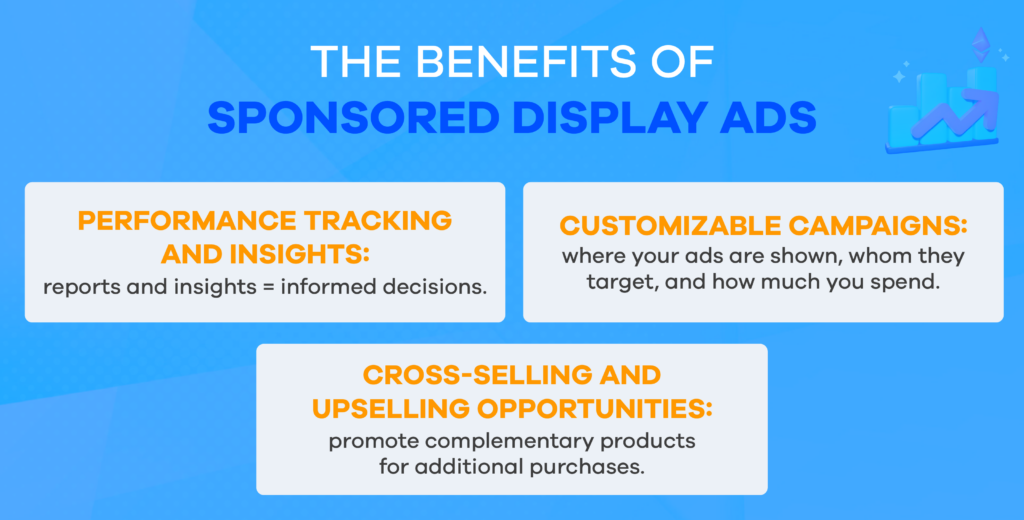

Amazon Sponsored Display Ads Placement

Amazon Sponsored Display Ads offer a variety of placement options to maximize visibility and engagement.
Here’s an overview of where these ads can appear:
- On Amazon.com:
- Product Detail Pages: Ads can be placed on pages of similar or complementary products, capturing the attention of shoppers already interested in related items.
- Search Results Pages: Display ads may appear alongside search results, making them visible to customers actively looking for specific products or categories.
- Amazon Home Page: Some ads are placed on Amazon’s main page, offering high visibility to a broad audience.
- Off Amazon:
- Third party Websites and Apps: Sponsored Display Ads extend beyond Amazon to various websites and apps, reaching customers as they browse other online platforms.
- Amazon Owned Properties: This includes placements on other Amazon owned sites and platforms, such as IMDb, where relevant.
- Across Devices:
- Desktop and Mobile: Ads are optimized for both desktop and mobile devices, ensuring visibility regardless of how customers access Amazon or other sites.
- Customizable Placements:
- Advertisers have some control over where their ads are placed, allowing for strategic positioning based on the target audience and campaign goals.
These placement options enable advertisers to reach potential customers at various touchpoints, both on and off Amazon, enhancing the likelihood of engagement and conversion.
Who can use Sponsored Display Ads
Sponsored Display ads on Amazon are accessible to a specific group of sellers and vendors, subject to certain eligibility criteria.
Here’s an overview of who can use these ads and the associated regulations and rules:
- Eligible Sellers:
- Professional Sellers: Only professional sellers on Amazon are eligible to use Sponsored Display ads.
- Enrolled in Amazon Brand Registry: Sellers must be enrolled in the Amazon Brand Registry, which requires a registered and active trademark.
- Eligible Vendors:
- Amazon Vendors: Manufacturers and distributors who sell their products directly to Amazon (as opposed to selling on Amazon as a third party seller) are eligible.
- Product Eligibility:
- Products Must Be in Stock: Only products that are in stock and available for sale can be advertised.
- Compliance with Amazon’s Policies: Products must comply with Amazon’s advertising policies and guidelines.
- No Restricted Products: Certain categories of products, such as adult products, used products, and products from closed categories, are not eligible for Sponsored Display ads.
- Geographic Availability:
- Sponsored Display ads are available in several countries, but availability can vary. It’s important to check whether the service is available in your specific marketplace.
- Account Health:
- Good Standing: Sellers and vendors must maintain good account health as per Amazon’s performance metrics.
- Budget Requirements:
- There are no minimum budget requirements for Sponsored Display ads, offering flexibility for businesses of all sizes.
- Ad Content and Creatives:
- Compliance with Creative Guidelines: The ad content, including images and text, must adhere to Amazon’s creative guidelines.
- Automatic Creative Generation: Sponsored Display ads often use automatically generated creatives based on the product listing, but customizations are available.
By meeting these eligibility criteria, sellers and vendors can leverage Sponsored Display ads to enhance product visibility, reach a wider audience, and ultimately drive more sales on Amazon.
Amazon Sponsored Display Ads’ Role in Your Sales Funnel
The sales funnel is a model that represents the customer’s journey from awareness to purchase. Understanding its structure is vital for effective marketing.
To develop a successful Amazon Display Ads sales funnel using the tree of thought reasoning system, we will explore various strategies.
Each strategy will be evaluated based on how closely it aligns with the primary goal of creating an effective sales funnel on Amazon. The deviation score is calculated using linear regression modeling, indicating how far each strategy deviates from the original objective. A lower deviation score suggests a closer alignment with the primary goal.
| ID | Strategy | Description | Deviation Score |
|---|---|---|---|
| 1 | Market Research | Analyzing target customer demographics and preferences on Amazon. | Deviation score: 0.1 |
| 2 | Ad Creative Development | Designing visually appealing and relevant ad creatives for display. | Deviation score: 0.3 |
| 3 | Keyword Optimization | Identifying and utilizing high-performing keywords for Amazon SEO. | Deviation score: 0.2 |
| 4 | Budget Allocation | Strategically allocating budget across different ad types and targeting options. | Deviation score: 0.4 |
| 5 | A/B Testing | Implementing A/B testing for ad creatives and messaging to optimize performance. | Deviation score: 0.5 |
| 6 | Analytics and Reporting | Regularly reviewing ad performance data to refine strategy. | Deviation score: 0.2 |
| 7 | Customer Feedback Integration | Incorporating customer feedback to improve ad relevance and engagement. | Deviation score: 0.6 |
| 8 | Cross-Promotion Strategies | Utilizing cross-promotion techniques with complementary products on Amazon. | Deviation score: 0.7 |
| 9 | Retargeting Campaigns | Implementing retargeting to re-engage potential customers who showed interest. | Deviation score: 0.3 |
| 10 | Seasonal Adjustments | Adapting the ad strategy to align with seasonal trends and shopping behaviors. | Deviation score: 0.4 |
Eva Impact
Eva’s PPC (Pay Per Click) and DSP (Demand Side Platform) services can play a pivotal role in aligning these elements.
Eva’s PPC services focus on optimizing your bids on Amazon, ensuring efficient use of your budget while targeting the desired audience. This service is particularly useful for campaigns with specific sales or lead generation goals.
On the other hand, Eva’s DSP services extend the scope of your campaign beyond Amazon. It enables the programmatic purchase of ads across a variety of platforms, aligning with your broader campaign goals and budget. With DSP, you can efficiently manage large-scale campaigns, targeting audiences across the web, which is particularly beneficial for goals related to brand awareness and reach.
How Much Does Amazon Charge for Sponsored Display Ads
Amazon’s charges for sponsored ads, specifically Amazon Sponsored Products, vary based on a few factors, primarily the advertising model and competition for targets. Amazon uses various ad models, meaning you pay depending on your chosen ad type.
Here’s a general overview:
- Bidding on Targets:
- When setting up a Sponsored Product ad on Amazon, you bid on specific targets, usually keywords.
- The competitiveness of these keywords influences your cost per click (CPC). Popular keywords typically have higher CPC rates due to increased demand.
- Auction-Based Pricing System:
- Amazon’s display advertising operates on an auction system.
- You set a maximum bid, which is the highest amount you’re willing to pay for a click.
- If your bid is among the highest, your ad is more likely to be displayed.
- Importantly, you pay only $0.01 more than the next highest bid when your ad is clicked.
- Control Over Budget:
- Advertisers have full control over their daily budget.
- This budget is the maximum amount you’re willing to spend per day on a specific campaign.
- Once the daily budget limit is reached, your ads will stop appearing for the rest of the day.
- Minimum Spend Requirement:
- Amazon requires a minimum spend of $1 for Sponsored Product ads.
- This allows for flexibility in budget management, enabling adjustments based on the return on investment (ROI) and campaign performance.
- Average CPC Range:
- There is no fixed rate for CPC; it varies.
- The average CPC on Amazon can range from as low as $0.02 to over $3.00.
- This variation depends on several factors, including the product category, the level of competition for the chosen keywords, and prevailing market trends.
Ad Placement and Performance
The cost can also vary based on ad placement (like top of search or product pages) and the performance of your ads. Better performing ads might have a lower CPC over time.
It’s important to regularly review and adjust your bids and budget based on the performance data Amazon provides, to ensure you’re getting the best return on your investment.
Remember, the actual cost will vary greatly depending on your specific product, competition, and market dynamics.
Conclusion
Amazon Display Advertising offers a powerful platform for brands to increase visibility and drive sales. By understanding your audience, crafting compelling creatives, monitoring performance, and continuously refining your approach, you can leverage Amazon’s vast reach and data-driven insights to achieve your marketing goals.

